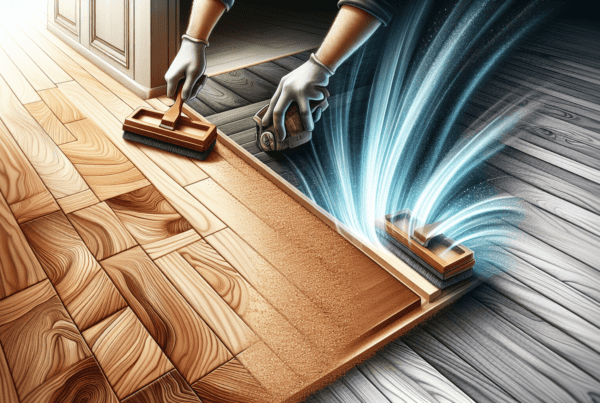Nestled in the heart of Wellington, there’s a gem that’s been bringing life back to worn-out wooden floors for years, and that’s the trusted Timber Floor Sanding & Finishing team. With their expert touch, our beloved wood floors transform from tired and dull to gorgeously vibrant and incredibly durable. Their commitment to quality and detail ensures that each floor they touch not only looks stunning but also stands the test of time. Join us in uncovering the magic they bring to homes across Wellington, making every step on these floors a testament to beauty and craftsmanship.
Importance of Trusted Timber Floor Sanding & Finishing
Timber flooring is a significant investment in any home, adding warmth, elegance, and value. Understanding the importance of trusted timber floor sanding and finishing is crucial for us to protect this investment and enhance our living spaces.
Protection of investment
We invest a substantial amount in our timber flooring, expecting it to last for years. Proper sanding and finishing act as a safeguard, protecting the wood from wear, tear, and damage. This process ensures that our flooring remains in pristine condition, maintaining or even increasing the value of our home over time.
Aesthetic appeal
The aesthetic appeal of well-maintained timber flooring is undeniable. Sanding removes the old, worn-out surface layer, revealing the fresh, untouched wood underneath. Finishing then enhances the natural beauty of the timber, bringing out the wood’s grain and colour, and complementing our home’s decor.
Longevity and durability
Sanding and finishing are key to extending the lifespan of our timber floors. These processes eliminate scratches, dents, and uneven areas, preventing further damage and making the floor more durable. A well-finished floor resists spills, stains, and fading, ensuring it remains vibrant and sturdy for years to come.
Health benefits
Timber floors contribute to a healthier living environment by not harboring allergens like dust mites or pet dander. Regular sanding and finishing keep the floors smooth, minimizing the accumulation of these allergens. Moreover, finishes used today are often low in volatile organic compounds (VOCs), making them safer for our indoor air quality.
Understanding Timber Floor Sanding
The process of sanding timber floors is essential in maintaining their beauty and integrity.
The sanding process explained
Sanding involves the removal of the top surface of a wooden floor by abrasive materials. We start with a coarse sandpaper to remove the old finish and imperfections, gradually moving to finer grits to smooth the surface, preparing it for finishing.
Types of equipment used
For efficient and effective sanding, various types of equipment are used. Drum sanders, edge sanders, and orbital sanders are among the most common. Each plays a vital role in achieving a smooth, uniform surface, ready for finishing.
DIY vs. professional sanding
While DIY sanding is possible, it requires skill, patience, and the right equipment. Professional sanding, on the other hand, guarantees a high-quality finish, saving us time and the potential cost of fixing mistakes. Professionals have the experience and tools to tackle common challenges smoothly.
Common sanding challenges
From uneven surfaces to managing dust, sanding comes with its set of challenges. Handling sensitive areas, avoiding sanding marks, or dealing with hard-to-reach spots need expertise. Additionally, dust management is crucial to maintain air quality and prevent the spread of dust throughout the home.
Timber Floor Finishing Options
After sanding, finishing is the next crucial step. The right finish not only enhances the appearance but also protects the floor.
Types of finishes available
There’s a variety of finishes available, including polyurethane, oil-based, and water-based finishes, each offering different levels of shine and protection. Wax finishes and penetrating oils are also popular choices for a more natural look.
Choosing the right finish for your home
The choice of finish depends on the usage of the space and personal preference. High-traffic areas benefit from durable, easy-to-maintain finishes like polyurethane. For those of us preferring a natural aesthetic, oil or wax finishes might be the right choice.
The application process
Application methods vary depending on the type of finish. Some require brushing, while others are applied with a roller or a pad. Each method requires precision and timing to ensure a smooth, even coat without bubbles or streaks.
Maintenance of different finishes
Maintenance varies with the type of finish. Polyurethane finishes might only need regular sweeping and occasional mopping, while oil finishes require periodic re-oiling. Understanding the maintenance requirements helps keep our floors looking great for longer.
Finding a Trusted Timber Floor Specialist in Wellington
When it comes to timber floor sanding and finishing in Wellington, finding a trusted specialist is key to achieving the best results.
Qualities of a trusted service provider
A trusted specialist has extensive experience, positive reviews, and a portfolio of completed projects. They should offer transparent pricing, detailed quotes, and a clear timeline for the project.
How to vet potential services
We start by researching online, looking for reviews and testimonials. Asking for references and checking previous work gives us insights into their quality and reliability. Additionally, verifying their qualifications and insurances is essential.
Importance of local expertise
A local specialist in Wellington will have specific knowledge about the types of timber common in the area and the challenges posed by the local climate. Their understanding of these aspects ensures a more tailored and effective service.
Reading reviews and testimonials
Reviews and testimonials provide valuable information about the experiences of previous clients. Positive feedback, especially regarding professionalism, reliability, and quality of work, is a good indicator of a service provider’s trustworthiness.
Preparation for Timber Floor Sanding and Finishing
Proper preparation is essential for a successful sanding and finishing project.
Clearing the workspace
The first step is to clear the workspace of furniture, rugs, and other items. This ensures a smooth workflow and protects our belongings from dust and damage.
Dealing with nails and protrusions
Before sanding, it’s important to check for and deal with nails, screws, or any protrusions in the floor. These can damage the sanding equipment and affect the quality of the finish.
The importance of a clean environment
A clean working environment minimizes dust and debris, resulting in a better finish. Ensuring the room is as dust-free as possible before beginning reduces the amount of dust that settles in the fresh finish.
Setting realistic timelines
Sanding and finishing can be time-consuming. Setting realistic timelines and expecting some disruption helps us plan accordingly and reduces stress. Professionals can give us an accurate timeline, allowing us to make necessary arrangements.
The Role of Technology in Timber Floor Sanding
Technological advancements have significantly improved the sanding process.
Latest advancements in sanding equipment
Modern sanding equipment is designed for efficiency and minimal dust. Dust extraction systems, for example, keep the workspace clean and air quality high. Advanced sanders also provide a more uniform surface faster than older models.
The impact of technology on efficiency
These technological advancements not only make the job quicker but also improve the quality of the finish. With better equipment, professionals can achieve a smoother finish in less time, with less effort.
Software for project management
Project management software helps specialists plan and track the progress of sanding projects. This software ensures better communication between us and the service provider, making the process smoother and more transparent.
Future trends in timber floor sanding
The future of timber floor sanding looks promising, with continuous improvements in equipment and techniques. Innovations aiming at even greater efficiency and environmental sustainability are expected to shape the industry.
Sustainable Practices in Timber Floor Sanding and Finishing
Sustainability is becoming increasingly important in all aspects of home improvement.
Use of eco-friendly products
Eco-friendly finishes and products with low VOC levels are better for the environment and our health. More of us are choosing these options, encouraging the industry to develop safer, more sustainable products.
Sustainability in the choice of timber
Choosing sustainably sourced timber or recycling existing wood floors is another way we contribute to environmental conservation. Sustainable timber is harvested responsibly, ensuring minimal impact on ecosystems.
Waste management during the sanding process
Proper waste management is crucial. Using advanced dust extraction systems reduces airborne particles, making cleanup easier and minimizing environmental impact. Disposing of waste materials responsibly further enhances the sustainability of the project.
Supporting responsible local suppliers
By choosing local suppliers who practice sustainability, we support the local economy and reduce our carbon footprint. Local specialists are more likely to use locally sourced materials, enhancing the overall sustainability of our timber floor sanding and finishing project.
Cost Considerations and Budgeting
Cost is an important factor in any home improvement project, including timber floor sanding and finishing.
Understanding the pricing structure
Pricing can vary significantly depending on the size of the area, the condition of the floors, and the type of finish chosen. Understanding the pricing structure helps us make informed decisions and avoid surprises.
Factors influencing cost
The condition of the floor, the level of detail required for sanding, and the choice of finish all influence the final cost. High-traffic areas might require more durable, and therefore more expensive, finishes.
How to budget for your project
Setting a realistic budget requires considering all potential costs, including preparation, sanding, finishing, and any unforeseen issues. Getting detailed quotes from professionals helps us plan accordingly.
Tips for cost-saving without compromising quality
Choosing the right professional can save us money in the long run by avoiding costly mistakes. Preparing the area ourselves, selecting a finish that balances cost and durability, and maintaining the floor properly to extend the time between sandings are all ways to save money without compromising quality.
Common Mistakes to Avoid
Avoiding common mistakes ensures the success of our timber floor sanding and finishing project.
Skipping the preparation stage
Skipping preparation can lead to subpar results. Ensuring the floor is clean, free of nails, and fully prepared is crucial for a smooth finish.
Underestimating the timeline
Underestimating how long the project will take can lead to frustration. Accepting that quality work takes time ensures a stress-free process.
Choosing the wrong type of finish
The wrong finish can detract from both the appearance and durability of the floor. Considering the room’s use and traffic level helps us choose the right finish.
Neglecting the need for professional advice
Attempting to tackle the project without professional advice can result in costly mistakes. Consulting with a specialist ensures that we make informed decisions throughout the process.
FAQs on Timber Floor Sanding and Finishing
How long does the process take?
The time required varies depending on the size of the area and the floor’s condition. A professional can provide a more accurate timeline after assessing the floor.
Is it possible to live in the house while the floors are being done?
It’s possible, but not recommended. Dust and fumes can be disruptive, and the area being worked on will be inaccessible. Arranging alternative accommodation is advisable.
How often should timber floors be sanded and finished?
This depends on the usage and traffic. Generally, floors should be sanded and refinished every 10 to 15 years to maintain their appearance and durability.
Can all types of timber floors be sanded?
Most timber floors can be sanded, but the process may vary depending on the type of wood and its condition. Some engineered or very thin floors may not be suitable for sanding. A professional assessment is necessary to determine feasibility.
Timber floor sanding and finishing in Wellington, or anywhere else, requires understanding, preparation, and the right professionals to achieve the best results. By considering the points outlined above, we can ensure our timber floors remain beautiful and durable for years to come.







